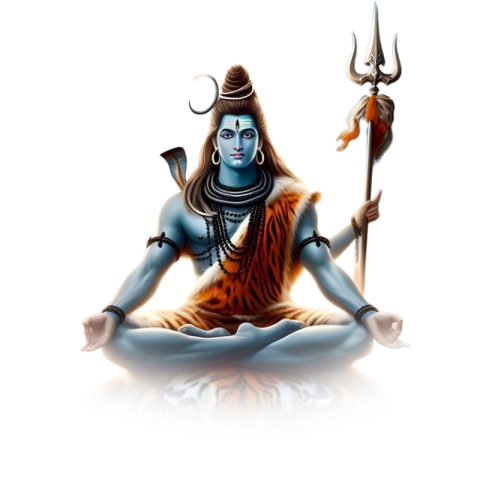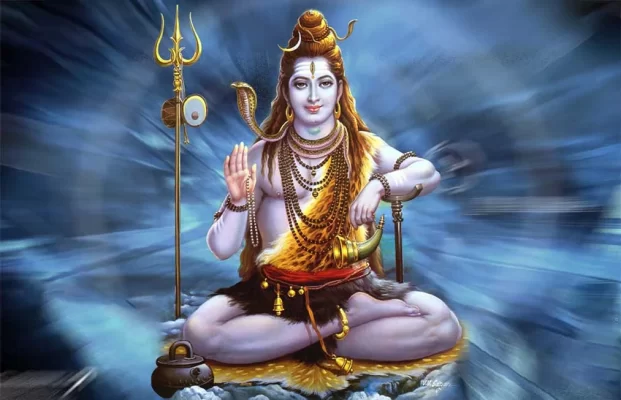Wavs
Lord Shiva

Lord Shiva, one of the principal deities in Hinduism, holds a central place in the Trimurti, the divine trinity of Brahma (the creator), Vishnu (the preserver), and Shiva (the destroyer or transformer). Here’s an in-depth look at Lord Shiva:
Mythological and Symbolic Attributes:
-
Role as Mahadeva: Lord Shiva is often referred to as Mahadeva, which translates to “Great God” or “Supreme God.” He is believed to be timeless, formless, and transcendent, representing the ultimate reality (Brahman) beyond creation.
-
Appearance and Symbols:
- Iconography: Shiva is typically depicted with a third eye on his forehead, symbolizing wisdom and insight. His hair is adorned with a crescent moon, and the Ganga River flows from his matted locks, symbolizing purity and divine energy.
- Trishula: He holds a trident (trishula), representing his power to destroy ignorance and evil.
- Damru: Shiva is also depicted with a small drum (damru), which symbolizes the cosmic sound that creates and sustains the universe.
-
Family and Consorts:
- Parvati: Shiva’s consort is Goddess Parvati (also known as Shakti or Uma), who embodies feminine energy and is revered as the Mother Goddess.
- Ganesha and Kartikeya: Shiva and Parvati have two sons: Ganesha, the elephant-headed god of wisdom and beginnings, and Kartikeya (Skanda), the god of war and victory.
Roles and Responsibilities:
-
Destroyer and Transformer: Shiva’s role as the destroyer in the Trimurti signifies his function in ending the cosmic cycle of creation, preservation, and dissolution. He destroys the old to make way for new beginnings.
-
Ascetic and Yogi: Shiva is often depicted as an ascetic who meditates in the Himalayas, representing detachment from worldly desires and ultimate liberation (moksha). He is also revered as the Lord of Yoga (Yogeshwara), embodying mastery over meditation and spiritual discipline.
-
Protector and Benefactor: Despite his fierce appearance and association with destruction, Shiva is believed to be compassionate towards his devotees. He grants blessings, protection, and guidance to those who seek his aid.
Worship and Festivals:
-
Temples and Pilgrimage Sites: There are numerous temples dedicated to Lord Shiva across India and other countries with Hindu communities. Prominent sites include Kashi Vishwanath in Varanasi, Somnath in Gujarat, and Pashupatinath in Nepal.
-
Maha Shivaratri: This major Hindu festival celebrates Shiva’s cosmic dance of creation, preservation, and destruction. Devotees observe fasting, perform rituals, and offer prayers to seek Shiva’s blessings.
Contemporary Relevance:
-
Cultural Influence: Shiva’s symbolism and teachings resonate deeply in Hindu philosophy and culture, emphasizing the cycles of life, death, and rebirth, as well as the pursuit of spiritual enlightenment.
-
Universal Appeal: Beyond India, Shiva’s worship has spread globally among spiritual seekers drawn to his embodiment of transcendence, meditation, and cosmic balance.
In essence, Lord Shiva embodies various facets of divinity, from his role as the destroyer of ignorance and ego to his compassion as the beneficent protector of all existence. His worship spans millennia, continuing to inspire millions in their spiritual quests and daily lives.

Lord Shiva, a central figure in Hindu mythology and spirituality, is revered as the supreme deity who embodies various roles and attributes. While Shiva’s biography isn’t presented in a conventional linear narrative like a human biography, his essence and mythology are rich with symbolism and profound teachings.
Mythological Background and Origin:
According to Hindu mythology:
-
Birth: Shiva is often depicted as timeless and without beginning or end. He emerges from the cosmic abyss when the universe was created. His birth is sometimes attributed to being born from a cosmic egg (Hiranyagarbha) or as an emanation of the supreme consciousness (Brahman).
-
Marriage to Parvati: One of the most well-known stories revolves around his marriage to Goddess Parvati (also known as Shakti or Uma). Parvati performs intense penance to win Shiva’s favor, eventually marrying him. Their union symbolizes the harmonious balance of masculine and feminine energies in the universe.
Iconography and Symbolism:
-
Physical Attributes: Shiva is typically depicted with:
- Blue Throat: Due to consuming poison during the churning of the ocean (Samudra Manthan), which turned his throat blue, he is known as Neelakantha (the blue-throated one).
- Matted Hair: His hair is adorned with the crescent moon (symbolizing time), the Ganga River (symbolizing purity), and a snake (representing the kundalini energy).
- Third Eye: Representing wisdom, destruction of ignorance, and transcendence.
-
Weapons and Objects: Shiva holds:
- Trident (Trishula): Symbolizing control over the three gunas (qualities of nature) and his power to destroy.
- Drum (Damru): The sound of which symbolizes creation and the rhythm of the universe.
Roles and Attributes:
-
Destroyer and Transformer: Shiva’s role as the destroyer (Mahakala) signifies his ability to dissolve the universe at the end of a cosmic cycle, making way for regeneration and new creation.
-
Yogi and Ascetic: Often depicted in deep meditation in the Himalayas, Shiva embodies detachment, austerity, and the path to spiritual liberation (moksha).
-
Lord of Dance (Nataraja): His cosmic dance (Tandava) symbolizes the rhythmic cycles of creation, preservation, and destruction. It also represents the balance of life’s energies.
Worship and Festivals:
-
Temples: Shiva is worshipped in numerous temples across India, with major pilgrimage sites like Kashi Vishwanath in Varanasi, Somnath in Gujarat, and Pashupatinath in Nepal.
-
Maha Shivaratri: A major Hindu festival celebrating Shiva’s marriage to Parvati and his dance of creation. Devotees observe fasting and night-long vigils, chanting prayers and hymns in his honor.
Philosophical Teachings:
-
Shiva Sutras and Shaivism: Shiva’s teachings, encapsulated in texts like the Shiva Sutras, emphasize the path of self-realization, meditation, and liberation from worldly attachments.
-
Compassion and Grace: Despite his fierce form, Shiva is believed to be compassionate towards his devotees, offering blessings and guidance on their spiritual journey.
-
Maha Shivaratri: This is one of the most important festivals dedicated to Lord Shiva. It usually falls in the month of February or March, on the 14th night of the waning moon (Krishna Paksha) in the Hindu month of Phalguna. Devotees observe fasting, perform rituals, and offer prayers throughout the night.
-
Pradosham: Pradosham is observed twice a month, specifically on the 13th day (Trayodashi) of both the waxing (Shukla Paksha) and waning (Krishna Paksha) phases of the moon. It is believed to be an auspicious time for worshiping Lord Shiva and seeking his blessings for health, wealth, and prosperity.
-
Shravan Somvar Vrat: During the Hindu month of Shravan (typically July-August), Mondays (Somvar) are considered especially auspicious for Shiva worship. Many devotees observe fasting and perform special poojas on these days.
-
Rudra Abhishekam: This is a powerful pooja performed by pouring milk, water, honey, and other sacred items over a Shiva lingam while chanting Vedic mantras. It can be performed on special occasions, festivals, or auspicious days according to personal or family traditions.
-
Makar Sankranti: Celebrated on January 14th or 15th every year, this festival marks the transition of the Sun into the zodiac sign of Capricorn (Makara). It is considered auspicious for Shiva worship, particularly in places like the holy city of Varanasi.

Birth and Early Life:
- Emergence from the Cosmic Ocean: According to some versions of Hindu mythology, Shiva emerges from the cosmic ocean (Samudra Manthan) when gods (Devas) and demons (Asuras) churn the ocean to obtain the nectar of immortality (amrita). He is initially seen as a pillar of light (Linga) that both astonishes and bewilders the gods and demons alike.
Marriage to Parvati:
-
Sati and Shiva: Sati, the daughter of Daksha Prajapati (one of the progenitors of mankind), marries Shiva against her father’s wishes. In a fit of rage and disrespect towards Shiva, Daksha insults him at a grand sacrificial ceremony. Unable to bear the humiliation, Sati immolates herself. This act leads Shiva into a deep grief, and in his sorrow, he withdraws from the world and begins intense ascetic practices.
-
Rebirth of Parvati: Sati is reborn as Parvati (daughter of the mountain king Himalaya) with the sole purpose of marrying Shiva. She undergoes severe penance to win his favor. Impressed by her devotion and determination, Shiva finally agrees to marry Parvati. This union symbolizes the perfect balance of masculine and feminine energies in the universe.
Adventures and Deeds:
-
Destroyer of Tripura: Shiva destroys the three demonic cities (Tripura) built by the demon trio—Taraka, Tarakaksha, and Vidyunmali—using a single arrow, thus earning the epithet “Tripurantaka.”
-
Incarnation as Ardhanarishvara: Shiva takes the form of Ardhanarishvara, a composite androgynous deity representing the unity of masculine and feminine energies. This form symbolizes the inseparable nature of Shiva and Parvati.
Cosmic Dance (Tandava):
- Nataraja: Shiva performs the cosmic dance of Tandava, symbolizing the rhythmic cycles of creation, preservation, and destruction. The dance is a manifestation of his divine energy (Shakti) and illustrates the eternal cosmic balance.
Devotion and Bhakti:
- Bhaktas and Legends: Numerous stories highlight Shiva’s compassion towards his devotees. Examples include Markandeya, a young sage protected from death by Shiva’s grace, and Bhasmasura, a demon who is tricked by Shiva and ultimately destroyed.
Symbolism and Teachings:
- Third Eye: Shiva’s third eye represents wisdom, inner vision, and the ability to destroy ignorance.
- Ganga on His Head: The river Ganga flowing from Shiva’s hair symbolizes purification and auspiciousness.
- Trishula and Damru: His trident (Trishula) signifies control over the three gunas (qualities of nature), and the damru represents the cosmic sound of creation.
Worship and Festivals:
- Shiva Temples: Pilgrimage sites like Kashi Vishwanath in Varanasi and temples dedicated to Pashupatinath in Nepal attract millions of devotees.
- Maha Shivaratri: Celebrated annually, this festival honors Shiva’s marriage to Parvati and his cosmic dance. Devotees fast, meditate, and chant mantras to seek his blessings.





